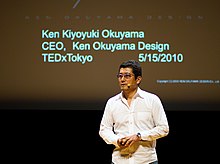
The 700 series is a Japanese Shinkansen high-speed train type built between 1997 and 2006, and entering service in 1999. Originally designated as "N300" during the development phase, they formed the next generation of Shinkansen vehicles jointly designed by JR Central and JR-West for use on the Tokaido Shinkansen, Hakata Minami Line and the San'yō Shinkansen. Though it has since been withdrawn from service on the Tokaido Shinkansen, it still operates on the San'yō Shinkansen and Hakata Minami Line.

The E2 series is a Japanese high-speed Shinkansen train type operated by East Japan Railway Company on the Tohoku Shinkansen high-speed lines in Japan since 1997. They are formed in 8- and 10-car sets. The 8-car sets were used on the Hokuriku Shinkansen, and the 10-car sets are on Tohoku Shinkansen services. The 10-car sets can be coupled to E3 series sets using couplers hidden behind retracting nose doors.

The E3 series (E3系) is a Japanese Shinkansen high-speed train type built for Komachi services which commenced on 3 June 1997, coinciding with the opening of the new Akita Shinkansen "mini-shinkansen" line, a regular 1,067 mm narrow-gauge line between Morioka and Akita re-gauged to 1,435 mmstandard gauge. Later versions of the E3 series were also introduced for use on Yamagata Shinkansen Tsubasa services. Both "mini-shinkansen" lines join the Tohoku Shinkansen, providing services to and from Tokyo.
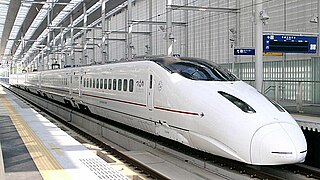
The 800 series (800系) is a Japanese Shinkansen high-speed train type operated by Kyushu Railway Company on the Kyushu Shinkansen high-speed rail line. Built by Hitachi, the trains were introduced on the all-stops Tsubame services from March 2004.

The Komachi (こまち) is a high-speed shinkansen service between Tokyo and Akita in Japan, operated by the East Japan Railway Company since March 1997. It is the only shinkansen service that runs on the Akita Shinkansen, and uses E6 series trains. Between Tokyo Station and Morioka, it couples with Tōhoku Shinkansen E5 series Hayabusa and formerly E2 series for E3 series respectively. After Morioka, the Komachi service continues along standard gauge tracks that were converted from narrow gauge. Because it then runs on tracks that have grade crossings, its maximum speed from Morioka to Akita is 130 km/h (80 mph), compared to 320 km/h (200 mph) on the Tohoku Shinkansen.
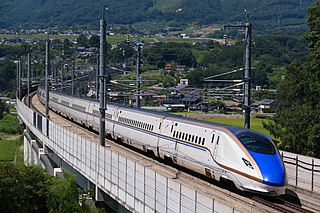
The Hokuriku Shinkansen (北陸新幹線) is a high-speed Shinkansen railway line jointly operated by East Japan Railway Company and West Japan Railway Company, connecting Tokyo with Kanazawa in the Hokuriku region of Japan.
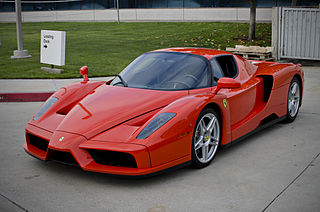
The Ferrari Enzo, officially marketed as Enzo Ferrari, is a mid-engine sports car manufactured by Italian automobile manufacturer Ferrari and named after the company's founder, Enzo Ferrari. It was developed in 2002 using Formula One technology, such as a carbon-fibre body, F1-style automated-shift manual transmission, and carbon fibre-reinforced silicon carbide (C/SiC) ceramic composite disc brakes, as well as technologies not allowed in F1, such as active aerodynamics. The Enzo generates substantial amounts of downforce through its front underbody flaps, small adjustable rear spoiler and rear diffuser, which work in conjunction to produce 3,363 newtons (756 lbf) of downforce at 200 km/h (124 mph) and 7,602 newtons (1,709 lbf) of downforce at 300 km/h (186 mph), before decreasing to 5,738 newtons (1,290 lbf) at top speed.

The Akita Shinkansen (秋田新幹線) is a Mini-shinkansen rail line in Japan. Serving the Kantō and Tōhoku Regions of the country, it links Tokyo and Akita in Akita prefecture. From Tokyo to Morioka in Iwate prefecture, it operates on the Tōhoku Shinkansen tracks. From Morioka to Ōmagari, it uses the Tazawako Line tracks. The section from Ōmagari to Akita use the Ōu Main Line tracks.

The Maserati Birdcage 75th is a functional concept car designed and developed by a Pininfarina design team led by Lowie Vermeersch, including Jason Castriota and Giuseppe Randazzo under the direction of Ken Okuyama. It was first introduced at the 2005 Geneva Auto Show. It was named to honor the classic Maserati Birdcage race cars of the 1960s and Pininfarina's 75th anniversary. The Birdcage was the result of a collaboration between Maserati, Pininfarina and Motorola to showcase their technical expertise. The car was completed in just 2 months, following a fast pace design phase using 3D renderings.
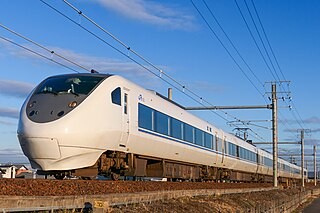
The Shirasagi (しらさぎ) is a limited express train service in Japan operated by the West Japan Railway Company since 1964. It runs between Nagoya and Kanazawa. Shirasagi (白鷺) is the Japanese name for the "egret", a white heron.

Kamome (かもめ) is a limited express train service operated by JR Kyushu in Japan. It operates between Hakata and Nagasaki on the Kagoshima Main Line and the Nagasaki Main Line. Kamome means seagull in Japanese.

The Azusa is a limited express service operated by the East Japan Railway Company, which mainly run between Shinjuku and Matsumoto via the Chūō Main Line and Shinonoi Line. The name Azusa is taken from the Azusa River in Matsumoto, Nagano. On the Chūō Main Line, limited express Kaiji also runs between Tokyo / Shinjuku, and Kōfu / Ryūō.

The Tsubasa (つばさ) is a high-speed Shinkansen train service operated on the Yamagata Shinkansen by East Japan Railway Company since July 1992. The name was formerly used for a limited express service operated by Japanese National Railways (JNR) and later by JR East, which ran from Ueno to Akita, and was discontinued in 1992 when the new shinkansen service commenced.
The Gauge Change Train(GCT) or Free Gauge Train (フリーゲージトレイン, "FGT") is the name given to a Japanese project started in 1994 to develop a high-speed train with variable gauge axles to allow inter-running between the 1,435 mm (4 ft 8+1⁄2 in) standard gauge Shinkansen network, and the 1,067 mm (3 ft 6 in) narrow gauge regional rail network.

The E6 series (E6系) is a Japanese Shinkansen high-speed train type operated by East Japan Railway Company on Komachi "mini-shinkansen" services on the Tōhoku Shinkansen and Akita Shinkansen from Tokyo to Akita since 16 March 2013. A pre-series set was delivered in June 2010 for extensive testing, with 23 full-production sets delivered between November 2012 and spring 2014.

The E7 series and W7 series Shinkansen are Japanese high-speed train types operated by East Japan Railway Company and West Japan Railway Company, respectively. They were jointly developed.

The E353 series (E353系) is a DC tilting electric multiple unit (EMU) train operated by the East Japan Railway Company in Japan on limited express services on the Chūō Main Line since December 2017.

The Class E956 (E956形), branded "ALFA-X", is a ten-car experimental Shinkansen train operated by East Japan Railway Company in Japan to test technology to be incorporated into future trains operating at speeds of up to 360 km/h (225 mph). The name is an acronym for "Advanced Labs for Frontline Activity in rail eXperimentation". The first train was unveiled on May 9, 2019. Its test run is mainly performed in sections between Sendai and Shin-Aomori of the Tohoku Shinkansen line, and, in some cases, on the Hokkaido Shinkansen line.

The E8 series (E8系) is a Japanese Shinkansen high-speed train type on order for Tsubasa services announced on 3 March 2020. It is intended to replace the E3 series, raising the top speed of the service from 275 to 300 kilometers per hour. It is designed by Ken Okuyama, in cooperation with Kawasaki Heavy Industries.

The Nishi Kyushu Shinkansen is a Japanese Shinkansen high-speed rail line on the northwest part of Kyushu Island that is operated by the Kyushu Railway Company. A segment of the line that connects Nagasaki to Takeo-Onsen commenced service on 23 September 2022. The line runs parallel to the existing Nagasaki Main Line and has a total length of 66 kilometers (41 mi), making it the shortest high-speed Shinkansen railway line in Japan in terms of length.
